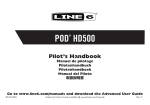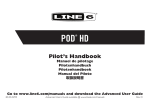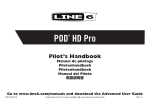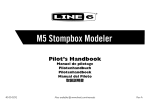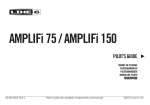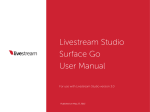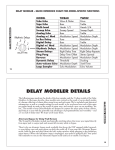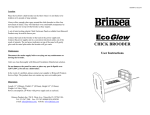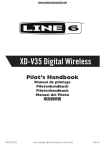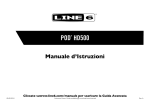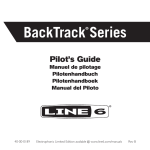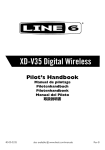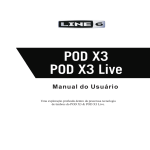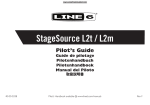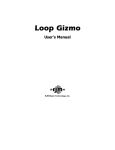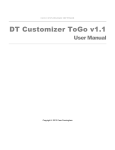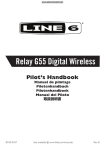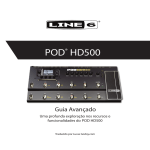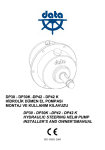Download POD® HD500 Pilot`s Handbook
Transcript
® POD HD500 ® Pilot’s Handbook Manuel de pilotage Pilotenhandbuch Pilotenhandboek Manual del Piloto 取扱説明書 Go to www.line6.com/manuals and download the Advanced User Guide 40-00-0281 Advanced Users Guide available @ www.line6.com/manuals Rev A Important Safety Instructions CAUTION RISK OF ELECTRIC SHOCK DO NOT OPEN WARNING : TO REDUCE THE RISK OF FIRE OR ELECTRIC SHOCK, DO NOT REMOVE SCREWS. NO USER-SERVICEABLE PARTS INSIDE. REFER SERVICING TO QUALIFIED SERVICE PERSONNEL. WARNING : TO REDUCE THE RISK OF FIRE OR ELECTRIC SHOCK, DO NOT EXPOSE THE APPLIANCE TO RAIN OR MOISTURE. CAUTION: This equipment has been tested and found to comply with the limits for a Class B digital device pursuant to Part 15 of FCC Rules. Operation is subject to the following two conditions: (1) This device may not cause harmful interference, and (2) this device must accept any interference received, including interference that may cause undesired operation. The lightning symbol within a triangle means “electrical caution!” It indicates the presence of information about operating voltage and potential risks of electrical shock. The exclamation point within a triangle means “caution!” Please read the information next to all caution signs. Please Note: Line 6, POD and Variax are trademarks of Line 6, Inc. registered in the U.S. and other countries. DT50 is a trademark of Line 6, Inc. All rights reserved. SERIAL NO: You should read these Important Safety Instructions. Keep these instructions in a safe place • • • • • • • • • • • • • • • • • • • Read these instructions. Keep these instructions. Heed all warnings. Follow all instructions. Do not use this apparatus near water. Clean only with dry cloth. Do not block any ventilation openings. Install in accordance with the manufacturer’s instructions. Do not install near any heat sources such as radiators, heat registers, stoves, or other apparatus (including amplifiers) that produce heat. This apparatus shall be connected to a MAINS socket outlet with a protective earthing connection. Do not defeat the safety purpose of the polarized or grounding-type plug. A polarized plug has two blades with one wider than the other. A grounding type plug has two blades and a third grounding prong. The wide blade or the third prong are provided for your safety. If the provided plug does not fit into your outlet, consult an electrician for replacement of the obsolete outlet. Protect the power cord from being walked on or pinched particularly at plugs, convenience receptacles, and the point where they exit from the apparatus. Only use attachments/accessories specified by the manufacturer. Use only with the cart, stand, tripod, bracket, or table specified by the manufacturer, or sold with the apparatus. When a cart is used, use caution when moving the cart/apparatus combination to avoid injury from tip-over. Unplug this apparatus during lightning storms or when unused for long periods of time. Refer all servicing to qualified service personnel. Servicing is required when the apparatus has been damaged in any way, such as power-supply cord or plug is damaged, liquid has been spilled or objects have fallen into the apparatus, the apparatus has been exposed to rain or moisture, does not operate normally, or has been dropped. The apparatus shall not be exposed to dripping or splashing and that no objects filled with liquids, such as vases, shall be placed on the apparatus. WARNING: To reduce the risk of fire or electric shock do not expose this apparatus to rain or moisture. The appliance coupler is used as the disconnect device, the disconnect device shall remain readily operable. Connect only to AC power outlets rated: 100/120V 220/240V 50/60Hz (depending on the voltage range of the included power supply). • Prolonged listening at high volume levels may cause irreparable hearing loss and/or damage. Always be sure to practice “safe listening.” • Service is required when the apparatus has been damaged in any way, such as: • power-supply cord or plug is damaged. • liquid has been spilled or objects have fallen into the apparatus. • the unit has been exposed to rain or moisture. • the unit is dropped or the enclosure is damaged. • the unit does not operate normally or changes in performance in a significant way. WELCOME TO POD HD500 Thank you for inviting POD HD500 home with you! Our engineers have worked long and hard to bring you the new POD HD series of multi-effects processors. Featuring brand new HD Amp modeling, POD HD500 also features effects taken from our industry standard M series of products, M9 & M13. But that’s not all! POD HD processors are the first products to feature L6 LINK, an exclusive connectivity protocol that opens up a whole new world of features and control for serious musicians when used with other compatible products (for example, DT50 series guitar amplifiers from Line 6!) When you’re ready to get deeper, we recommend you get the Advanced User Guide & Model Gallery for POD HD500 by visiting us online at www.line6.com/manuals. And while you are online, be sure and download the free POD HD500 Edit software application from our Downloads page. Basic operations are covered here in this user manual, so let’s get started. FRONT PANEL CONTROLS SAVE ENTER AMP & FX ON / OFF P RE SE TS 19 TS PR ES S F O R S E T LIS HOLD FOR SYSTEM & I/O VIEW DBL PRESS TO ASSIGN CTL MOVE 18 1. Display - The LCD is your window into the power of the POD HD500. Signal Flow View you can use the 4 Way Nav to highlight items in the signal chain. Pressing the MOVE Button allows you to “grab” that item and move it elsewhere in the signal path by using the 4 Way Nav. Press the MOVE Button again to “drop” the item into its new position. Home Pages - are the default view on your POD. There are 3 userselectable views for the Home Page. The Signal Flow View shows you all the amp and effects model "blocks" in your signal chain. From this view you can edit or move any component affecting your tone in the signal path. Press the VIEW button to switch focus to the Big User View, which shows you the bank and channel number where the current preset is stored. Press the VIEW button once more to show the Performance View. This view shows what each Footswitch (#13) controls. Edit Pages - These pages show all parameters available to tweak for a processing block or system setup page. 2. From the Set List page you can use the MOVE button to reposition presets to a new Set List or memory location. Double-press the MOVE button to assign a controller to any effects block parameter. Note: Amp Models have some conditional behavior. Advanced User Guide for details. 7. Presets Knob / Set Lists Button - Turn this knob to select through all of the stored presets. Presets are saved in groups called Set Lists making it easy to keep different presets grouped for specific applications. To load a new Set List, press the Set Lists button and use the 4-Way Nav to highlight a Set List. Press ENTER to load a selected Set List or press the Set Lists knob to exit the Set List page without making any changes. While highlighting a Set List, Double-press the ENTER button to easily edit the order of the presets within the Set List. 3. Save Button - Press this button to save changes to a factory preset or 4. View Button - Press this button to switch from any of the 3 user selectable Home Page views – Signal Flow View, Big User View, or Performance View. Press and hold the VIEW button to access the SYSTEM & I/O edit pages where you can assign the Display contrast, configure inputs/ your very own custom creations – every preset location is available to be overwritten. Use the Multi-Function knobs to rename the preset and select the Set List and preset location. Press the SAVE button again to complete the save operation. Press any other button to cancel. outputs and assign the control behavior of your footswitches. 5. 4 Way Nav Pad - Used to move through options within the various pages 6. Move Button - Press this to perform various move functions. From the of POD HD500. Press the pad left, right, up, and down to highlight items in the Display. This pad is also used to navigate through multiple pages. See the Enter (ON/OFF) Button – While in Signal Flow view, press this button to turn effects blocks on or off. Double-press ENTER to access deep edit pages. Deep edit pages display all of the editable parameters associated with the highlighted block. Hold ENTER to bring focus to Foot Switch Assign mode. The ENTER button is also used to load Set Lists and presets. 8. Multi-Function Knobs – These four knobs provide controls for various 9. Drive - DRIVE is like the gain knob on other amps; controlling how functionality depending on the display’s current focus, but generally speaking the knobs will control parameters displayed in the lower quarter of the main display as follows: Knob 1 controls the upper left parameter, Knob 2 controls the lower left parameter, Knob 3 controls the upper right parameter, and Knob 4 controls the lower right parameter. Please refer to the Advanced User Guide for more detail. much “dirt” or distortion you get in the sound. POD HD500 can run up to two amps at once so make sure you select the amp you want to be adjusting with the amp control (via the CTL: Amp parameter) before turning the DRIVE knob. 10. Tone Controls - BASS, MID, TREBLE and PRESENCE controls are customized for each Amp Model to give you optimal tonal control. When you turn any of these knobs, the display will briefly show the current settings of the DRIVE, BASS, MID, TREBLE and PRESENCE knobs. Remember, when running two amps to be sure to select the amp you want to adjust before turning these knobs. 11. Volume Knob - This adjusts the output level of your selected amp model without affecting the tone or distortion characteristic of the amp model. 12. Master Volume Knob - This controls the overall output level of POD HD500, including the headphone level. Changing the MASTER VOLUME level does not change your tone, so you can get the tone you want at any volume level. This setting is global and is not saved when you store settings into the POD HD500 memory locations. Note: POD HD500 will generally give the best signal-to-noise performance when you have the MASTER VOLUME control at maximum. With the MASTER VOLUME control turned down low, you may get extra hiss – which obviously isn’t what you want – if you turn up your mixer or recorder’s output to compensate. In order to allow you to set the MASTER VOLUME as high as possible when connecting to recording, mixing, and other studio gear, be sure you are plugging POD HD500 1/4-inch outputs into line level, not microphone or guitar level inputs. Line level inputs should allow you to turn POD HD500 MASTER VOLUME up all the way (or close to it) and thereby get the best sound possible. If your gear has inputs that function as mic/ line level inputs, try to set the trim for those inputs to the minimum level, and POD HD500 MASTER VOLUME to maximum, when setting levels. There is also a switch which allows you to set the line outputs to amp (instrument) or line level. Having said all that, it is recommended that you start with the MASTER VOLUME control set to minimum and slowly turn the control clockwise towards maximum before any audio clipping (the bad kind of distortion) occurs. 13. Foot Switches - In standard operation your foot switches work as follows: Bank Up, Down - These choose amongst 16 banks of presets in your current Set List. Once you've navigated your way to a new bank, step on the A, B, C or D Foot Switch to actually load a preset from that bank. FS 1- FS 4 - (Top row) These assignable foot switches turn the effects and amp models on or off just like a MIDI controller or board full of analog pedals. A, B, C & D - (Bottom row) From the factory these foot switches provide instant access to presets A-D from the current bank selected. You can change this behavior in the SYSTEM & I/O pages to provide four additional assignable on/off controls. Even in this mode (FS 5-8) you can still access presets by pressing the Bank Up, Down Footswitches. Pressing either the Bank Up, Down Footswitches cues the current bank for access to A, B, C or D – loading the preset causes the footswitches to instantly revert to FS 5-8 mode. Tap Tempo - Stomping the TAP button a few times sets the tempo of all effects with the TAP feature assigned to them. Most time-based effects in POD HD500 can have the TAP setting affect parameters set to a specific note value. Press and hold TAP to enter Tuner Mode. Now you've got a fancy chromatic tuner in your Display. Looper - Equips your POD HD500 with up to 48 seconds of looping capability. The PRE/POST footswitch allows you to set your loop recording and playback either before amp and effects modeling or after (LED off=PRE, LED on=POST). Recording in PRE mode (LED off) let’s you record your guitar, then audition various effects with your loop playing back, while recording in POST mode (LED on) captures your amp and effects in the loop and then layer different sounds by changing presets. Stomp REC/OVERDUB to start recording a loop then stomp PLAY/STOP to end loop and immediately start playback. You can overdub additional parts by again, stomping the REC/OVERDUB switch. Stomp PLAY/STOP to stop or start playback. If you make a mistake on your last overdub press UNDO to erase it. Use 1/2 SPEED at any time to double the loop time normally available at Full Speed and hear playback at half the original loop speed - this changes the pitch of everything down 1 octave too. Press REVERSE to hear your playback backwards - xirdneH imiJ ekil tsuJ. You can exit Looper Mode even when a loop is still playing to switch presets or turn amps and effects on/off and return back to add additional loops. How cool is that? Showing the Performance View while in Looper mode displays “dynamic labels” for the foot switch functions. For example: The first foot switch will perform a Record function, so the label says Record. If you press Record, the first footswitch now controls an Overdub function and the label is updated to reflect the function the foot switch will perform. All of the looper functions are displayed in a similar dynamic fashion. Note: Changing the state of the PRE/POST footswitch while the loop is playing back can dramatically change the volume, so be careful! 14. Expression Pedals - The lights to the left of this pedal show when an Expression Pedal is engaged and active. The pedal equipped on your POD HD500 can toggle between EXP 1 and EXP 2 functionality via the pedal’s integrated toe switch. You can add a second Expression Pedal to give simultaneous controls of EXP 1 and EXP 2 via the PEDAL 2 Input on the back of your POD HD500. You can assign these pedals for Volume, Wah, or to tweak multiple parameters of any effects and amp models in your signal path. REAR CONNECTIONS PEDAL 2 GUITAR IN CD/MP3 INPUT UNBALANCED OUTPUT L/MONO R/MONO BALANCED OUTPUT LEFT RIGHT PHONES AUX IN MIC LINE STOMP FX RETURN L/MONO RIGHT FX SEND TRS STEREO VARIAX S/PDIF OUT INPUT MIDI OUT/THRU USB L6 LINK CONNECT TO L6 LINK ONLY 9VDC 2.5A Min MIC LEVEL 15 16 17 18 19 20 21 15. Pedal 2 - Connect a standard expression pedal, such as the Line 6 EX- 1, and you'll be able to assign it to control the Volume, Wah or effects parameter functions. 16. Guitar In - Plug your guitar cable in here. If you are using high gain or active pickups you may want to set the Guitar In switch on the top of your POD HD500 to PAD. There's really no rule, use what sounds best. 17. CD/MP3 Input - Connect a CD player, MP3 player, drum machine or other device here, and you’ll hear it through the PHONES, UNBALANCED OUTPUT and BALANCED OUTPUT. Use your device’s output control to adjust the volume relative to your guitar tone. Start with the volume on your device at its lowest setting and bring it up to the volume you desire. 18. Unbalanced Output - connect 1/4" cables here to send your sound to a guitar amplifier, recorder, mixer or PA system. Set the 1/4" OUT switch on top of your POD HD500 to AMP when sending to a guitar amp or LINE for devices with -10dBV inputs typical of mixers and recorders. 19. Balanced Output - connect balanced XLR cables here for an ideal connection to digital recorders or as direct sends to the house mixer or PA when playing live. If you are experiencing hums and buzzes, set the XLR switch on top of your POD HD500 to LIFT to eliminate ground loops between your equipment. 20. Phones - Plug headphones in here. The volume is set by the MASTER VOLUME knob. Always use safe listening practices, starting with a low level and turning up from there if you need more volume. 21. Aux In - This mono, unbalanced 1/4" input can be used for a second guitar or just about any other instrument. Visit the SYSTEM & I/O edit pages for AUX IN routing options. 22 POWER 23 24 25 26 27 28 29 22. Mic Input - plug in your microphone here and use the MIC LEVEL control to get a nice, healthy level. Visit the SYSTEM & I/O edit pages for routing options. 23. Effects Loop - provides a stereo (when using a TRS cable) FX SEND and a stereo FX RETURN. Set the FX LOOP LEVEL switch to LINE to operate at higher peak-to-peak voltage, making it optimal for line level devices. The loop can also be used with stomp boxes by setting the FX LOOP LEVEL switch to STOMP. 24. Variax Digital Interface - this input provides power and a direct digital audio connection between a Line 6 Variax guitar or bass and the POD HD500. Visit the SYSTEM & I/O edit pages to assign signal routing options. When you are ready to connect a Variax, use only Line 6 supplied Variax-compatible cables – not standard Ethernet or other cables – to avoid damage to the jack. You can learn more about the Variax family of guitars, each one giving you the sound of an entire guitar collection in one instrument, at www. line6.com. 25. S/PDIF - This jack sends out 24-bit digital versions of the Direct Out signals. The SYSTEM & I/O edit pages lets you choose the sample rate and adjust level. 26. MIDI - Connect POD HD500 to your MIDI equipment to send and receive Program Change Messages for selecting presets. POD HD500 MIDI OUT connects to another device's MIDI IN; its MIDI IN goes to another device's MIDI OUT. Visit www.line6.com/manuals for a comprehensive MIDI implementation chart. 27. USB - The USB jack lets you connect directly to a USB equipped computer for direct recording and to take advantage of many computerpowered features including free, downloadable editor/librarian software, POD HD500 Edit. Read the Advanced Guide available online to learn more. 28. L6 LINK – is a powerful, proprietary connection developed by Line 6 to enable easy, reliable, one-cable connectivity between various Line 6 products. In the case of the DT50 Series guitar amplifiers and POD HD (300/400/500) series multi-effects processors, this connection allows both products to sync and communicate uniquely with each other. L6 LINK passes both audio and control data in a single cable, and the resulting operation allows users to plug a single cable from their POD HD family processor into a DT50 series amp and receive many incredible benefits: • No additional cables are required to connect a POD HD (300/400/500) to a DT50 series guitar amplifier. • Changing Tone settings (for example) on either the POD HD or DT50 immediately updates the other, with the result that both units stay perfectly in sync. • Edit a preset on a POD HD by simply turning knobs on the DT50 as one would any other guitar amp, then save it on the POD HD to perfectly recall every time the preset is selected. • This one is crazy cool! Calling up a particular amp model or preset on the POD HD enables the DT50 to dynamically reconfigure itself in the analog realm to optimize its components to match the source amplifier. Change your preset on a POD HD, and the DT50 will immediately align itself in the analog realm to such things as the appropriate Class A or A/B operation, Biasing method, Feedback topology, Triode/Pentode operation of the power tubes and more! • Automatic sensing allows linked multiple (daisy chained) amps to operate in a variety of ways, depending on which POD HD is connected. At minimum, all POD HD multi-effects support stereo operation with linked DT50s, and POD HD500 supports up to four uniquely linked amps with configurations like wet/dry mode easily available. 29. Power - Connect your Line 6 Power Supply here to power the unit. Unplug to turn it off. Wrap your power supply cable around the “T” shaped cable tree once or twice to prevent an accidental disconnect. M Series Effects, HD Amp Modeling, Flexible Signal Routing, and Dynamic DSP… All this sonic power don’t come for free bud – Being able to route up to 8 M Series Effects in any order, pre or post amp, and even a parallel split would be plenty powerful on its own. Add the option to run 2 HD Amp Models, the most authentic amp modeling magic yet, and you gotta start to think – Oh, that’s a spicy meatball! To create models with such authenticity, some models require more DSP resources than others. Rather than greatly reduce the amount of models and routing options in POD HD500, we decided to implement a Dynamic DSP system which allows you to create a huge variety of sounds from a single box! Some models, such as Pitch Shifters and Reverbs take a lot of the available DSP. Most other effects can require much less, allowing for an increase to the amount of available simultaneous FX. If there is not sufficient DSP to load a particular model, the model select function will indicate that the model is unavailable. Models which are bypassed reserve the DSP they require when enabled to prevent DSP spikes when stomping FX on and off. Unused models can be set to a disabled or “model of none” block to free up more DSP. It might sound complex but it’s really quite simple and will be virtually invisible to many users. See the Advanced User Guide for more details. DISPLAY ICON REFERENCE HD Amp Model Block Reverb Effect Block Dynamic Effect Block Filter Effect Block Distortion Effect Block Pitch Effect Block Wah Effect Block Effects Loop EQ Effect Block 48 Second Looper Modulation Effect Block Multi Effect (Foot switch On/Off assigned to more than one effect) Delay Effect Block VISIT US ONLINE Get the Advanced Guide and more online at www.line6.com/manuals Get up to speed on your POD HD500 deep editing features with our Advanced User Guide available online. While you’re online be sure to register your POD or simply fill out and mail us your included registration card. Registering gets you all set up for warranty service should you have an issue with your amp, and also qualifies you for contests, special offers and more.











